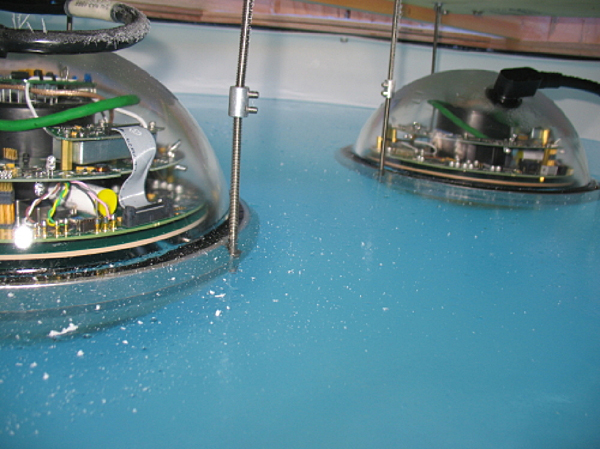IceCube: neutrino telescope in a block of ice
A team of physicists, technicians and engineers of an American research institute published an interesting report on their participation in the construction of the giant Antarctic IceCube detector at the South Pole (there is a photo of their houses at the Amundsen-Scott polar station). By the way, on December 22 these guys will open a blog where they will constantly talk about their life in Antarctica.
IceCube is a very interesting design of thousands of photosensors surrounding 1 cubic kilometer in a block of ice. This ice "cube" (more precisely, a regular hexagonal prism) will become the world's largest neutrino detector. Perhaps it will help to obtain the first evidence of the existence of multiple dimensions in the Universe, confirming string theory , on the basis of which the Unified Theory, which is the Grail of modern physics, was formulated. The Large Hadron Collider was also created approximately for this purpose - in order to find a particle (Higgs boson) and find deviations from the Standard Model . In connection with the breakdown of the LHC, IceCube can give us the first evidence.
String theory predicts the existence of sterile neutrinos that come to us from other dimensions with a speed supposedly (for an observer) exceeding the light barrier (as well as the speed of propagation of gravity for us, observers, also supposedly exceeds the light barrier). Actually, it is these sterile neutrinos that the detector will look for. IceCube consists of a variety of optical detectors neatly frozen in ice at a depth of 1450 to 2450 meters (tunnels in ice are made with hot water). Each detector consists of 60 sensors assembled in a kilometer chain. The whole construction is shown schematically in the illustration below.

')
It turns out that a huge block of ice is used as a detector, which is surrounded on all sides by sensors frozen in there. Here are the individual optical sensors.

They should register rare neutrino collisions with water molecules, in which muons emit causing weak light flashes.
The IceCube project started in 2002, and work on the installation of detectors began in 2005. Now installed only half of them. However, they all start working immediately after installation: they managed to detect the first neutrino in February 2006. The launch of a full-fledged system is scheduled for 2011.
This is almost entirely an American project, in which 33 US research institutions are participating. Only little support is provided by the scientific institutions of Belgium, Germany, Japan and Sweden.
IceCube is a very interesting design of thousands of photosensors surrounding 1 cubic kilometer in a block of ice. This ice "cube" (more precisely, a regular hexagonal prism) will become the world's largest neutrino detector. Perhaps it will help to obtain the first evidence of the existence of multiple dimensions in the Universe, confirming string theory , on the basis of which the Unified Theory, which is the Grail of modern physics, was formulated. The Large Hadron Collider was also created approximately for this purpose - in order to find a particle (Higgs boson) and find deviations from the Standard Model . In connection with the breakdown of the LHC, IceCube can give us the first evidence.
String theory predicts the existence of sterile neutrinos that come to us from other dimensions with a speed supposedly (for an observer) exceeding the light barrier (as well as the speed of propagation of gravity for us, observers, also supposedly exceeds the light barrier). Actually, it is these sterile neutrinos that the detector will look for. IceCube consists of a variety of optical detectors neatly frozen in ice at a depth of 1450 to 2450 meters (tunnels in ice are made with hot water). Each detector consists of 60 sensors assembled in a kilometer chain. The whole construction is shown schematically in the illustration below.

')
It turns out that a huge block of ice is used as a detector, which is surrounded on all sides by sensors frozen in there. Here are the individual optical sensors.

They should register rare neutrino collisions with water molecules, in which muons emit causing weak light flashes.
The IceCube project started in 2002, and work on the installation of detectors began in 2005. Now installed only half of them. However, they all start working immediately after installation: they managed to detect the first neutrino in February 2006. The launch of a full-fledged system is scheduled for 2011.
This is almost entirely an American project, in which 33 US research institutions are participating. Only little support is provided by the scientific institutions of Belgium, Germany, Japan and Sweden.
Source: https://habr.com/ru/post/46756/
All Articles